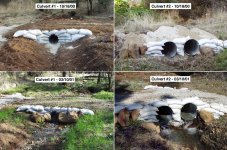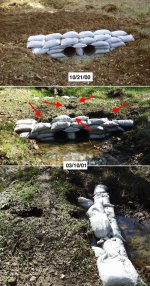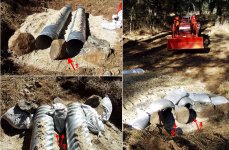Harv
Elite Member
- Joined
- Aug 22, 2000
- Messages
- 3,346
- Tractor
- Kubota L2500DT Standard Transmission
Some of you may recall my very first tractor project last October was to build 3 separate culverts which were designed to give me tractor access to the "back forty" of my property. (For those of you who missed this exciting saga, you can find the thread or check out the Cliff's Notes version on my website.)
At that time I promised to let y'all know how they held up once the rainy season hit. Well, we just had our rainy season and the results are in. Now, I said I would share the successes and the failures alike, so all I have to say is, two out of three ain't bad! /w3tcompact/icons/crazy.gif
The rain itself kept me away from the property for five weeks in a row, but apparently there were some dandy storms up there, and the culverts were indeed tested. The first culvert was a single 12-inch pipe, and it held up just fine, as did culvert #2 (the "big" one), with it's dual 18-inchers. The rains have stopped for the time being, so the flow is down to a trickle -- a trickle which will last probably through mid-summer due to mountain snowmelt.
The attached photo shows these two culverts as they were on or near completion, and how they look today. Not the most exciting pictures -- unless you're planning on building a culvert soon yourself. /w3tcompact/icons/wink.gif
Culvert #3? Well ... that's the next message or two.

At that time I promised to let y'all know how they held up once the rainy season hit. Well, we just had our rainy season and the results are in. Now, I said I would share the successes and the failures alike, so all I have to say is, two out of three ain't bad! /w3tcompact/icons/crazy.gif
The rain itself kept me away from the property for five weeks in a row, but apparently there were some dandy storms up there, and the culverts were indeed tested. The first culvert was a single 12-inch pipe, and it held up just fine, as did culvert #2 (the "big" one), with it's dual 18-inchers. The rains have stopped for the time being, so the flow is down to a trickle -- a trickle which will last probably through mid-summer due to mountain snowmelt.
The attached photo shows these two culverts as they were on or near completion, and how they look today. Not the most exciting pictures -- unless you're planning on building a culvert soon yourself. /w3tcompact/icons/wink.gif
Culvert #3? Well ... that's the next message or two.





